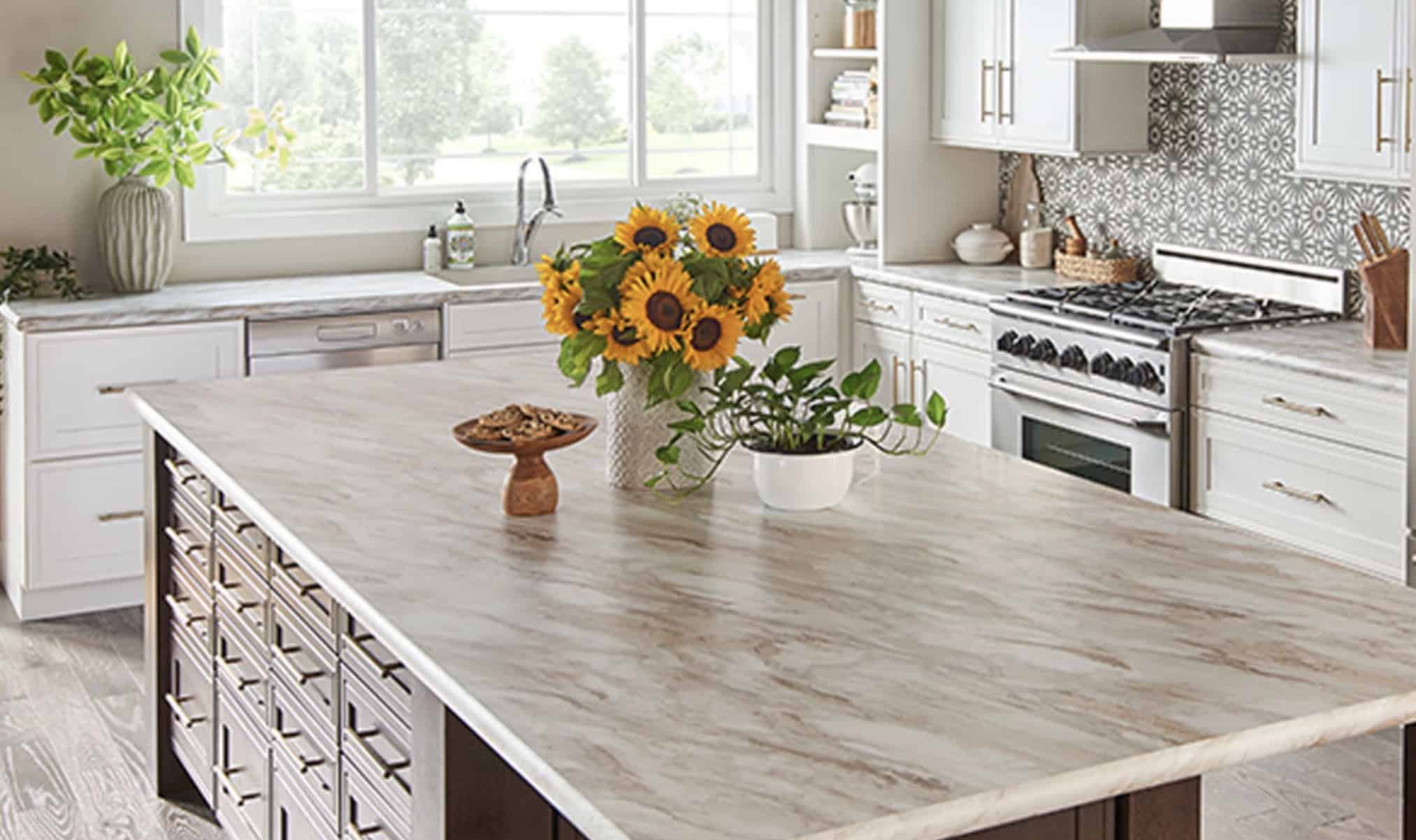What are laminate countertops? They are a popular and versatile choice for kitchens and bathrooms, offering a wide range of design options, durability, and affordability. In this comprehensive guide, we will delve into the material composition, design possibilities, installation process, maintenance requirements, and comparative advantages of laminate countertops.
Material Composition and Durability

Laminate countertops are composed of multiple layers of materials, each serving a specific purpose. The core layer, typically made of particleboard or medium-density fiberboard (MDF), provides structural support and stability. The decorative layer, which gives the countertop its visual appeal, is a high-pressure laminate (HPL) that consists of paper impregnated with phenolic resins and bonded under heat and pressure.
The manufacturing process of laminate countertops involves several steps. First, the core material is cut to the desired shape and size. Then, the decorative laminate is applied to the core using a special adhesive. The laminate is then subjected to high pressure and heat, which causes it to bond permanently to the core.
Finally, the edges of the countertop are trimmed and sealed to prevent moisture penetration.
Durability, What are laminate countertops
Laminate countertops are known for their durability and longevity. They are resistant to scratches, stains, and heat, making them a practical choice for kitchens and other high-traffic areas. Compared to other materials, such as natural stone or solid surface, laminate countertops are more affordable and easier to maintain.
They also come in a wide range of colors, patterns, and finishes, providing homeowners with a variety of options to choose from.
Design Options and Customization

Laminate countertops offer an extensive range of design options, allowing homeowners to personalize their kitchens to match their unique tastes and décor. These countertops come in a myriad of colors, patterns, and textures, providing endless possibilities for customization.
Colors
Laminate countertops are available in a wide spectrum of colors, from classic neutrals like white and black to vibrant hues like red, blue, and green. This diversity enables homeowners to select a color that complements their kitchen cabinetry, flooring, and overall décor.
Patterns
Laminate countertops offer a vast array of patterns, including solid colors, granite-like patterns, marble-like patterns, and wood-like patterns. These patterns can mimic the look of natural materials while providing the durability and affordability of laminate.
Textures
Laminate countertops come in various textures, such as smooth, textured, and embossed. Smooth textures create a sleek and modern look, while textured and embossed textures add depth and character to the countertop surface.
Complementary Kitchen Styles
Laminate countertops can be used to complement a wide range of kitchen styles. For example, solid-color laminate countertops with a smooth texture can enhance a contemporary kitchen, while granite-like laminate countertops with a textured surface can complement a traditional kitchen.
Wood-like laminate countertops can add warmth and coziness to a rustic kitchen, while marble-like laminate countertops can create an elegant and sophisticated atmosphere in a transitional kitchen.
Installation and Maintenance: What Are Laminate Countertops
:max_bytes(150000):strip_icc()/laminate-countertop-ideas-1821210_hero_10961-2a93b127aee64592aa77fe17f51d2c13.jpg)
Laminate countertops are generally easy to install and maintain, making them a popular choice for homeowners. Here’s an overview of the installation and maintenance process:
Installation
- Prepare the cabinets by ensuring they are level and square.
- Cut the laminate countertop to size using a circular saw or table saw.
- Apply a thin layer of adhesive to the underside of the countertop.
- Place the countertop on the cabinets and secure it with screws or nails.
- Trim the excess laminate around the edges.
- Seal the edges with a sealant to prevent moisture from seeping in.
Maintenance
- Clean laminate countertops regularly with a mild detergent and water.
- Avoid using harsh chemicals or abrasive cleaners.
- Wipe up spills immediately to prevent stains.
- Protect the countertop from heat by using trivets or hot pads.
- Avoid cutting directly on the countertop, as it can damage the surface.
Comparison with Other Countertop Materials

Laminate countertops offer unique advantages and disadvantages compared to other popular countertop materials. Understanding these differences can help you make an informed decision for your kitchen or bathroom.
Cost Considerations
Laminate countertops are generally the most affordable option, making them a budget-friendly choice. Granite and quartz are more expensive, while butcher block falls in between.
Environmental Impact
Laminate countertops are made from recycled materials, making them a more sustainable option than granite or quartz, which are quarried from natural resources. Butcher block is also a sustainable choice as it is made from renewable wood.
Overall Value Proposition
Laminate countertops offer a good value for the price. They are durable, easy to maintain, and come in a wide range of designs. Granite and quartz are more durable and luxurious, but they come with a higher price tag. Butcher block is a good compromise between affordability and durability.
| Material | Advantages | Disadvantages |
|---|---|---|
| Laminate | Affordable, durable, easy to maintain, wide range of designs | Not as durable as granite or quartz, can be damaged by heat |
| Granite | Durable, heat-resistant, luxurious | Expensive, difficult to maintain, limited color options |
| Quartz | Durable, heat-resistant, non-porous | Expensive, can be difficult to repair |
| Butcher Block | Durable, warm and inviting, easy to repair | Requires regular maintenance, can be damaged by water |
Concluding Remarks
In conclusion, laminate countertops present a compelling combination of style, durability, and cost-effectiveness. Whether you are seeking a classic or contemporary aesthetic, laminate countertops offer a versatile and practical solution for your kitchen or bathroom.
